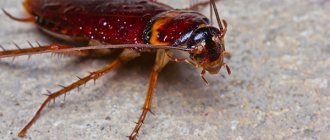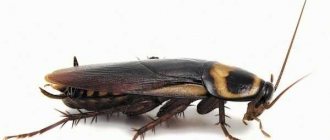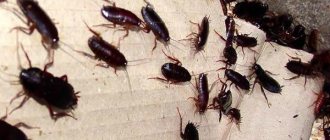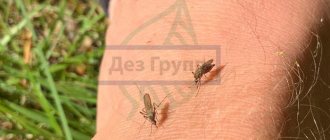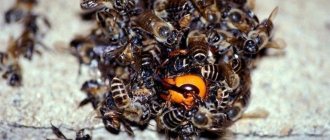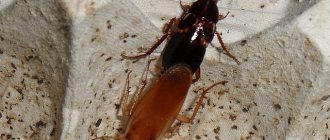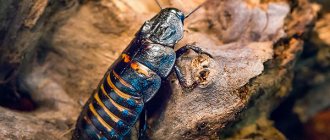A cockroach is an arthropod insect from the superorder Cockroach-like, order Cockroaches (Blattoptera, Blattodea).
None of the versions of the origin of the Russian word “cockroach” has been precisely confirmed. According to some etymologists, cockroaches got their name from the Chuvash word “tar-aqan”, which means “runaway”, or the Turkic “taz” (“to run away”).
How do cockroaches increase their population in an apartment?
Prussians are one of the most ancient animals on our planet. Throughout their existence, they have perfectly adapted to all the hardships of life. It is because of this that there are often cases where they cannot be removed from the premises by any means.
The female cockroach is a prime target because she gives birth to new members of the swarm. Therefore, you need to make a lot of effort to get rid of it.
How do barbels reproduce?
Nature took care of these insects and endowed them with good abilities for procreation. To hatch offspring, the female does not need good living conditions. She can lay eggs anywhere and anytime.
Not many people know how many
“babies” a female cockroach with an egg During one period of “pregnancy”, she produces from 20 to 50 individuals. She makes about 10 clutches in her entire life. It follows from this that the minimum number of offspring produced by one female is 150 individuals, in some cases the figure can reach up to 400.
Transformation of egg into adult
Prussians have several stages of development:
The duration of the development period varies and depends on several environmental factors - food availability, habitat humidity and air temperature.
The red cockroach reaches adulthood in 3-6 months, while the black cockroaches develop from 6 months to 2 years.
If a red cockroach is raised in a warm environment, it can reach puberty faster (in 3 months). In the opposite case, under unfavorable conditions, development is significantly delayed - 3-4 years.
The larva molts 6 times and becomes more and more similar to an adult barbel (imago). Most insects that live near humans are not able to reproduce.
To reach maturity, an adult cockroach must live for approximately 30 weeks. During such a period, one female cockroach with an egg produces at least a hundred babies.
Sexual differences in cockroaches
Cockroaches are dioecious insects. The reproductive system of males and females has a rather complex structure. You can distinguish a female cockroach from a male either by dissecting the insect under a microscope and studying its internal structure, or by visual inspection.
How to determine gender?
There are three main external differences between female and male cockroaches:
Outwardly, it is easiest to distinguish a female from a male by the first two characteristics. The male is more slender and his wings are visible to the naked eye.
The intimate life of parasites
If food, water and comfortable temperature conditions are available, the breeding season of cockroaches is not limited to a certain season; insects breed all year round. When a female reaches puberty, her genitals begin to secrete a special odorous substance that attracts males, signaling their readiness to mate. For the same purpose, the female flaps her wings.
The larger wings of the male also play an important role in the process. They serve as a supporting platform on which the partner can comfortably sit. Cockroaches mate for only a couple of minutes, after which the male goes to look for a new partner.
How do cockroaches reproduce?
Since cockroaches reproduce year-round, the colony grows very quickly at home. The attitude towards the offspring is also very important. For example, red cockroaches (Prussians) have become the most common type of domestic cockroaches, not only because they reproduce quickly, but also because of how carefully they care for their offspring. The female carries the eggs with her until the larvae are ready to emerge. And for the first time, several females take care of the hatched small cockroaches at once.
Full life cycle and developmental features
Cockroaches go through an incomplete transformation cycle, bypassing the pupal stage. Their life cycle includes the following stages:
Since cockroaches breed constantly, there are always pregnant females and larvae at different stages of development in the colony. This is another reason why it won't be easy to deal with the mustachioed invaders of your kitchen. Even if you destroy the adults, eggs will remain, from which a new generation of insects will soon emerge.
What is ootheca?
A pregnant cockroach is a female with a kind of “tail” visible at the back of her body. This is an ootheca - an elongated leathery sac into which the female lays eggs after fertilization. The eggs are perfectly packed, thanks to the foamy protein material that fills the entire free space of the capsule.
The ootheca performs several functions at once:
Representatives of some species protect the ootheca and carry it until the larvae appear, at the last moment placing the capsule in a secluded place. Other species do not value their offspring so much, and the female gets rid of the ooteca almost immediately, which significantly reduces the survival rate.
Growth and development of cockroaches
So, after the cockroach gives birth, that is, gets rid of the ootheca, larvae are born. At first, the nymphs do not run far from the place where they hatched, feeding mainly on the remains of the ootheca (if there is no other food nearby). The larvae are born very small (their size rarely exceeds 2 mm) and white. The chitinous cover becomes more durable and darkens over time.
After the first molt, they become more active, begin to explore the room, and look for food. In total, cockroach larvae molt from 6 to 8 times, with each molt increasing in size and becoming more and more similar to an adult insect.
Red cockroach Prusak: appearance
Red cockroach Prusak, appearance
The red cockroach (Blattella germanica) is part of the suborder of cockroaches, numbering about 2.4 thousand species. Prusak belongs to the phylum arthropods, class insects.
An adult red cockroach has an elongated oval body of light brown color, 10-16 mm long. The pronotum is slightly convex. In the upper part of the cephalothorax there are two dark stripes that reach the abdomen.
The cockroach has six legs, thanks to which it is able to move quickly. The paws of the Russian cockroach are long, with claws, between which there is a suction cup, thanks to which the red cockroach can move along the ceiling and vertical surfaces.
The Prusak moves incredibly fast (up to 5 km/h), making it almost impossible to catch. In just one second it can change its direction up to 25 times.
Insects have weak sexual dimorphism. The male's body is narrower, and the wings do not reach the edge of the rear pointed part of the body; the female's round abdomen is completely covered by them.
There are wings on the back. The insect is not able to fly for a long time, but if it falls, for example, from a wall, then thanks to them it can land smoothly.
On the sides of the head there are large compound eyes and a pair of long antennae. The antennae are an important organ of touch; along their entire length there are receptors that allow them to collect and process information. The cockroach has a gnawing type of mouthparts.
Red cockroaches live only 20-30 weeks.
Many people have heard that a cockroach can live for a long time without a head. This is true. The Prusak can live without a head for more than 10 days, after which it will die of thirst. In the absence of a brain, the body is controlled by ganglion nodes located throughout the body of the cockroach.
Can 1 cockroach reproduce?
Answering the question whether cockroaches are hermaphrodites, or in other words, whether they have both male and female sexual characteristics in their bodies, we can say a definite no. Among cockroaches there are males and there are females. In order to bear offspring, a female needs at least one sexual contact with a male.
True, some species can reproduce parthenogenetically. That is, in the female body, eggs develop without fertilization. The possibility of this form of sexual reproduction appeared in the process of evolution.
What happens if you accidentally eat a cockroach larva?
There are times when people call or write to us and ask in a voice with a slight tinge of panic what will happen if they accidentally eat a cockroach larva. Apparently, someone had a similar incident, a child could eat a piece of cookies with a small nymph, or the person himself did it.
Most likely, in this case nothing bad will happen. There is a chance that you will receive some portion of microbes, but you will not swallow anything fatal. So don't worry. But such situations themselves are very eloquent. That is, there is a possibility that a cockroach, which yesterday collected bacteria in the basement, is running through your products today.
Also keep in mind that any chocolate contains the remains of cockroaches in varying quantities. Not ours, of course, but tropical ones, but the difference is small - according to scientists, about half of the cases of chocolate allergy are, in fact, associated with an allergy to the remains of the bodies of cockroaches ground together with cocoa beans.
Therefore, one cockroach that someone accidentally ate with cookies or bread is nothing compared to the number of cockroaches that we constantly eat with chocolate.
How do domestic cockroaches reproduce, do they have a brain and wings - everything you wanted to know
What is the secret of such fertility of domestic cockroaches?
What structural feature makes them vulnerable to temperature changes? Is food that is familiar to us humans suitable for cockroaches? Let's consider the main points of the life cycle of these unsightly arthropods in order to choose the most effective methods of dealing with them and getting rid of the unpleasant neighborhood.
Cockroaches are ideal creatures from an evolutionary point of view. These arthropods are capable of surviving in truly extreme conditions.
They can survive without food for about 30 days, and without water for up to 7 days, they are very difficult to catch up with (cockroaches move at a speed of 22 m/s) and almost impossible to drown.
Surprisingly, these insects are able to survive without a head for a week , dying after this period from hunger!
Control measures
Protecting premises from cockroaches is a matter of paramount importance. People try every possible means. During the years of this war, the Prussians acquired good immunity to classical insecticides and many pesticides.
Hydroprene and methoprene are more effective drugs. They delay development and molting.
This species is not in danger of extinction, despite the active fight against it. Moreover, in a certain region at one time you may not find any individuals at all, or vice versa, there are so many of them that they will wander around during the day due to lack of food.
Secrets of Cockroach Fertility
Having met this timid and nimble arthropod in your own kitchen, you are unlikely to be interested in its gender.
How do cockroaches reproduce?
Reproduction occurs sexually, with the participation of both females and males. The process is preceded by mating games, when a female individual “attracts” a mustachioed partner by emitting an odorous secretion produced by the glands.
At the same time, the male, in an attempt to please, spreads his wings, trying to demonstrate exclusive flight skills.
If a couple has formed, then mating occurs and the male individual, using the genital plate, fertilizes the female, and then disappears back home.
In the female, a special membrane sac is formed in the back of the body - an ootheca, in which she forms a clutch.
The clutch in a leathery capsule can consist of 20-50 individuals for Prussians and 10-20 for black cockroaches. At the same time, the red female is more fertile (more than 12 clutches), in contrast to her black friend (up to 20-22 clutches over the entire life cycle).
The lifespan of these arthropods ranges from 4 months to 4 years.
The development of small cockroaches occurs in accordance with this scheme:
What affects the rate of reproduction
Undoubtedly, information about how quickly domestic cockroaches reproduce is significant for people who are faced with a similar problem.
The reproduction rate of domestic cockroaches is affected by their species. Red insects spread faster.
The rate at which a domestic cockroach reproduces is influenced by external factors. The embryo development process stops if the room temperature decreases. Their development resumes as soon as heat begins to flow to the ooteca.
Therefore, freezing is considered a popular way to get rid of breeding insects. To implement it, you need to open all windows for a while. But this method is available only to owners of country houses and people who can temporarily move to another premises.
Chemicals affect the speed at which the mustachioed pest reproduces. The larvae are located in a leathery sac, which protects them from toxic fumes and harmful components. But the ootheca can withstand 1-2 attacks. If the procedure is repeated 2-3 times within a month, then development will stop completely.
Some chemicals contain special regulator components. The cockroach breeding regulator works very simply. It affects the ability of insects to subsequently reproduce.
Sanitary and hygienic standards also influence the rate of reproduction. If the insects do not find food or water, they will leave the residential building.
Delicacies for uninvited guests: what cockroaches like to eat
Any organic food is a treat for a hungry insect.
However, these arthropods prefer high-calorie foods: They do not disdain organic remains from yesterday’s dinner decomposing in the trash can.
In case of total hunger, insects can even be content with:
Females are more voracious; they require 20-50 mg of food to survive, while males are content with half the volume. At the same time, insects do not spend energy on maintaining body temperature; they require a tiny amount of food to survive.
Temperature Armageddon for the domestic cockroach
The most comfortable temperature for a cockroach to exist is in the range from +2 to +28C.
Meanwhile, they belong to cold-blooded insects, their active life activity directly depends on the air temperature. If the thermometer readings tend to the 0 mark, then all physiological processes in the cockroach slow down.
However, high temperature (more than 30C) is also critical for these arthropods, since they cannot regulate their body temperature.
At the same time, the insect loses too much moisture, and eventually dies from dehydration and overheating: 35C is the temperature at which cockroaches die in the summer .
What you didn't know but would like to know about the life of cockroaches
Do cockroaches eat bedbugs ? No, unfortunately, cockroaches ignore these pests. However, if there is insufficient food (if the population has grown too large), they can include bug eggs in their diet.
Do cockroaches have wings ? Yes, these arthropods have a couple of well-developed wings. Of course, they won’t fly, and they won’t be able to, but they will be able to plan effectively in case of danger.
Do mice eat cockroaches ? Yes, they do; these rodents are omnivores and have an excellent appetite.
Do battering rams have a brain Yes, even they have a brain located in their head. But these insects also have a group of nerve cells (ganglia) scattered throughout the body that control motor and signaling functions - which is why a headless cockroach can survive for some time.
Do spiders eat cockroaches Of course, the whiskered insect can be an excellent source of building protein.
Do cats eat cockroaches?
Most often, domestic furries are disdainful of dining on these arthropods, but if they wish, they can also profit from them. This situation is complicated by the fact that cockroaches are carriers of many dangerous diseases, and a cat that eats an infected insect runs the risk of getting sick.
Can cockroaches live in a refrigerator?
The conditions in the freezer are simply unbearable for them, but in the refrigerator compartment, where +5C is maintained, insects can feel quite comfortable.
Do cockroaches have blood?
Yes, these insects have blood, but it is white. Cockroaches have an open circulatory system, with organs washed by blood and no small blood vessels.
What animal eats cockroaches ? The hedgehog is a fan of cockroaches; he feasts on them, supplying his body with protein.
Source
What animals eat cockroaches?
Although the cockroach is an almost indestructible insect due to its amazing fertility and adaptability to the most uncomfortable living conditions, they also have enemies. Some species of scorpions (for example, Centruroides gracilis, Euscorpius germanus and Hadrurus arizonensis) enjoy cockroaches; cats, hedgehogs, the centipede Scutigera coleoptrata, house spiders and tarantulas will not refuse to eat the cockroach. Cockroaches are hunted by the crested anole lizard, tree frog, northern leopard frog, and coastal toad. Cockroaches are a favorite treat for domestic chickens, and dead cockroaches are eaten by ants. Eulophid insects lay eggs in the ootecae of cockroaches, and the hatched eulophid larvae eat everything inside the cockroach capsule.
Peculiarities of reproduction and life cycle of cockroaches
If there is an uninvited guest in your house, in the form of an insect, then most likely it is a cockroach, since it loves to be in the neighborhood with a person. This insect looks like this: an elongated body, long mustache, two bulging eyes, and wings folded on the back. Domestic cockroaches are reddish to dark brown in color.
Cockroaches cause a lot of disgust for many people, but in order to fight them, it is important to know how they reproduce, what kind of offspring can be expected from them, as well as their life cycle. This will help you choose the most effective way to deal with them.
There are two types of parasites you can find in your home. These are red ones (Prussians) and large black ones. Most often, Prussians are closer to humans. If at least one female gets into your home, the population will increase at lightning speed.
But cockroaches have a peculiarity: their development can stop at the larval or nymph stage, which can live for 1.5 months and turn into an adult, and even several years, simply increasing in size.
It all depends on the environment. If it turns out to be good, then there will be several times more cockroaches in your house. Let's take a closer look at how cockroaches reproduce and what their life cycle is.
Reasons for the appearance of Prussians
Red cockroaches are synatropes, their lifestyle is closely related to humans. They live in homes all the time and actively spread with the help of humans. In fact, these animals are domesticated on their own.
Have you encountered cockroaches in your home?
Not really
Among the most common causes of pests in the house, it is worth noting:
- unsanitary conditions - dirty floors, unwashed dishes, scattered food;
- dysfunctional neighbors - pests enter through a ventilation hole or crack;
- faulty water and sewer pipes - a humid environment promotes active reproduction;
- accidental entry with things.
Features of development
Cockroaches are insects that have an incomplete development cycle.
Therefore, the stages of emergence and further development can be divided into several stages:
Ootheca is a unique way of developing oviposition. It varies in size, depending on the number of eggs it contains, and in color. The walls of the capsule are very dense, they can even resemble an eggshell. The future larvae located in it are arranged in even rows. The length of one larva is about 1 mm. The walls of the capsule provide reliable protection and guarantee that the survival rate of all larvae will be high.
After the larvae have fully matured, the ootheca bursts and small cockroaches emerge from it. Which go through the next stage. The young remain and live on the mother’s belly for some time, and then, after they begin to feed on their own, they scatter.
Life cycle of a domestic cockroach
Before you start fighting, it is important to know how long insects live, and whether they can go without food for a long time. If a cockroach lives in an apartment, then its lifespan depends on access to water and food. In order to survive in extreme conditions, and these are birds and snakes, they settle in human dwellings. Each cockroach can live from 4 months to 4 years.
The entire life cycle can be represented in three main stages:
After the larva appears, it begins rapid development until the adult insect appears, which is ready for mating. Only development in the womb or ootheca can be slow if the conditions are unfavorable. Sometimes the female may shed the capsule, but this occurs before the larvae are able to hatch.
After the larva has left the walls of the ootheca, it begins to grow. Increasing in size, it changes its upper chitin. Moreover, this happens several times, usually 6 times, until it develops wings and becomes a large adult.
Important! A red cockroach can live without food and liquid for 1 month, and a black cockroach can live for 2 months.
If a cockroach has nothing to eat, then it can devour its own kind, but those that are smaller. There are cases when cockroaches bite off the heads of their relatives. They can remain in this state for some time, since their vitality is very high. They continue to move and breathe through the holes that are located on the sides of the body.
All these features make populations of baleen insects rapidly growing and surviving. If you find one Prussian in you, then there will be others.
You need to find out in which apartment the breeding ground is located and contact special sanitary services for etching. Moreover, insects need to be poisoned on the entire floor. As a rule, multi-storey and apartment buildings are prone to cockroach infestations.
How do cockroaches reproduce?
Before mating, the female begins her dance first. She spreads her wings and shakes them, after which the males fly low and also begin to shake their wings. Their flight suggests that each of the males offers to choose himself.
Features of Prussians that help them survive in various conditions
- When cockroaches, a male and a female, mate for the first time, the gametes of the male are stored in the body of the latter. This allows her to produce offspring independently and not depend on the “male” half. That is, in her entire life it is enough for her to meet a male once in order to lay eggs herself in the future.
- Life without a head. If a barbel's head is torn off, the body continues to function normally and continue to live, only water and food do not enter it, as a result of which it dies from hunger.
- Don't breathe for 40 minutes. Scientists have hypothesized that this helped them survive in ancient times, when the atmosphere on Earth was underdeveloped.
- Pests are lazy. They don't move 75% of their life.
- They move quickly. Despite their small limbs, cockroaches can run at speeds of 5 km/hour.
- Eat food once every 30 days. They eat any food thanks to their powerful jaws.
- Difficult to catch. When a Prussian runs away from a person, it changes its trajectory several times.
- Don't be afraid of radiation. Because of this, they are able to survive an atomic explosion. This feature is achieved due to slow cell division.
- Protected wings. This allows them not to lose mobility and fly short distances.
